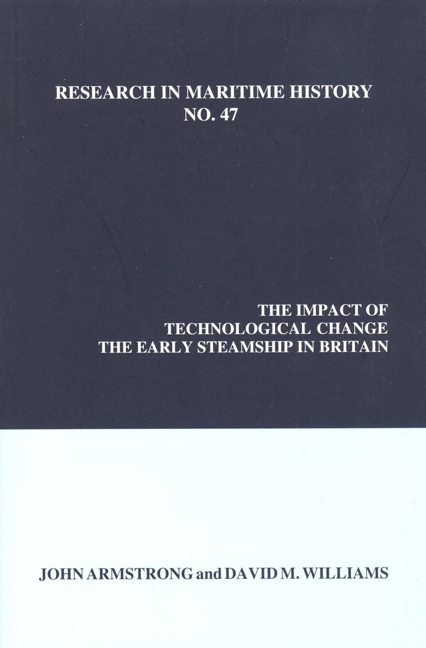Book contents
- Frontmatter
- Contents
- Series Editor's Foreword
- About the Authors
- Introduction
- Chapter 1 British Steam Navigation, 1812 to the 1850s: A Bibliographical and Historiographical Review
- Chapter 2 Some Official Listings of “Vessels Navigated by Steam” in Britain up to 1851: Evidence and Interpretation
- Chapter 3 The Steamboat, Safety and the State: Government Reaction to New Technology in a Period of Laissez-Faire
- Chapter 4 The Steamboat and Popular Tourism
- Chapter 5 The Thames and Recreation, 1815-1840
- Chapter 6 Steam Shipping and the Beginnings of Overseas Tourism: British Travel to North Western Europe, 1820-1850
- Chapter 7 Technological Advance and Innovation: The Diffusion of the Early Steamship in the United Kingdom, 1812-1834
- Chapter 8 The Steamship as an Agent of Modernisation, 1812-1840
- Chapter 9 “A New and Very Modern Business:” The Traffic and Operations of the Early Steamship
- Chapter 10 Promotion, Speculation and Their Outcome: The “Steamship Mania” of 1824-1825
- Chapter 11 The Perception and Understanding of New Technology: A Failed Attempt to Establish Transatlantic Steamship Liner Services, 1824-1828
- Chapter 12 The “Norwich Explosion” of 1817: A Local Tragedy of National Significance
- Chapter 13 Early Steamboat Services and Their Impact in North Wales, 1817-1840s
- Chapter 14 The Beginnings of a New Technology: The Constructors of Early Steamboats, 1812-1822
Chapter 5 - The Thames and Recreation, 1815-1840
- Frontmatter
- Contents
- Series Editor's Foreword
- About the Authors
- Introduction
- Chapter 1 British Steam Navigation, 1812 to the 1850s: A Bibliographical and Historiographical Review
- Chapter 2 Some Official Listings of “Vessels Navigated by Steam” in Britain up to 1851: Evidence and Interpretation
- Chapter 3 The Steamboat, Safety and the State: Government Reaction to New Technology in a Period of Laissez-Faire
- Chapter 4 The Steamboat and Popular Tourism
- Chapter 5 The Thames and Recreation, 1815-1840
- Chapter 6 Steam Shipping and the Beginnings of Overseas Tourism: British Travel to North Western Europe, 1820-1850
- Chapter 7 Technological Advance and Innovation: The Diffusion of the Early Steamship in the United Kingdom, 1812-1834
- Chapter 8 The Steamship as an Agent of Modernisation, 1812-1840
- Chapter 9 “A New and Very Modern Business:” The Traffic and Operations of the Early Steamship
- Chapter 10 Promotion, Speculation and Their Outcome: The “Steamship Mania” of 1824-1825
- Chapter 11 The Perception and Understanding of New Technology: A Failed Attempt to Establish Transatlantic Steamship Liner Services, 1824-1828
- Chapter 12 The “Norwich Explosion” of 1817: A Local Tragedy of National Significance
- Chapter 13 Early Steamboat Services and Their Impact in North Wales, 1817-1840s
- Chapter 14 The Beginnings of a New Technology: The Constructors of Early Steamboats, 1812-1822
Summary
Ever since the foundation of the first settlement that grew up to be London, the Thames has served as a vital means of trade and transport. The role of the river in these respects developed massively over time, notably from the sixteenth century onwards, and has been charted in Rupert Jarvis’ study on the metamorphosis of the port of London. Jarvis, however, failed to note that in the early nineteenth century, the Thames acquired a new function, that of recreation. Arguably before this date there was some recreational usage, the monarch and nobility besides making heavy use of the river for transport could also enjoy pleasure cruises in their great barges. At the other end of the scale, watermen might occasionally take part in races or celebratory events, and there were the “cutter clubs” of the late eighteenth century when apprentices clubbed together to maintain a boat on the river for Sunday trips to Richmond or Kew. What occurred from the early nineteenth century was recreational usage of a very different order, for it represented the beginnings of more popular recreation and even large-scale tourism which led to a new, closer relationship of ordinary Londoners with their river.
The factor that gave rise to this change was new technology in the form of the steamboat. Steam transformed shipping and ultimately replaced sail, but before 1850 steamboats operated largely on rivers and on coastal and short-sea routes. The special features of the steamboat were that it could operate independent of the wind. Likewise, it was far less affected by tides - a significant matter when operating in the Thames or other estuaries. Such qualities allowed steamboats to fix, and run to, schedules. Additionally, steamboats could run at faster speeds and offered a smoother passage as they did not regularly heel over like sailing vessels responding to the wind. In sum, the steamboat offered more reliable, more regular and, from a passenger standpoint, more comfortable services.
Steam arrived on the Thames in 1815. In January of that year, Marjory commenced services between London and Gravesend, operating between the two locations on alternate days.
- Type
- Chapter
- Information
- The Impact of Technological ChangeThe Early Steamship In Britain, pp. 97 - 118Publisher: Liverpool University PressPrint publication year: 2011



